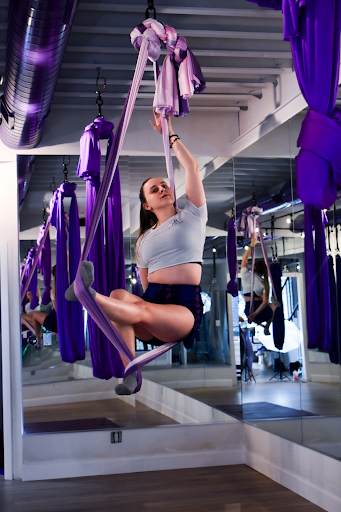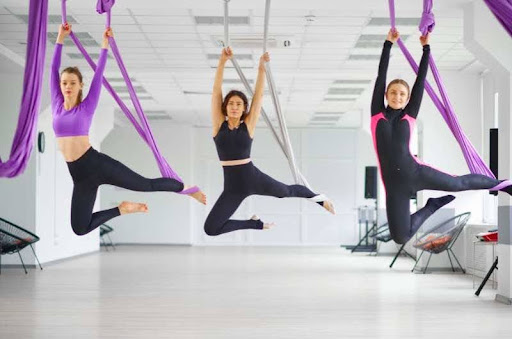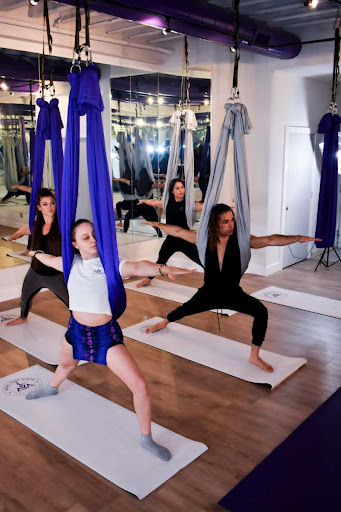Yoga has been practiced for thousands of years as a way to unite the mind, body, and spirit. From chanting ‘Om’ to performing Downward Dog, yoga grounds us in the present moment. In recent decades, yoga has exploded in popularity across the Western world for its numerous science-backed benefits to physical and mental health. An exciting evolution of traditional yoga is aerial yoga, which offers a fun new way to experience the many perks of yoga. If you find yourself wondering “What is aerial yoga good for?”, read on!
This in-depth aerial fitness guide will cover everything you need to know about aerial yoga and its unique benefits. We’ll compare aerial yoga to traditional yoga mat classes. You’ll also learn aerial yoga benefits backed by scientific research. By the end of this, you’ll be ready to take flight in your first aerial yoga class!
What is Aerial Yoga?

Aerial yoga is a modern style of yoga that incorporates soft, fabric hammocks suspended from the ceiling. Students perform poses while hanging in midair or using the hammock fabric for support. Classes may also incorporate short aerial acrobatics like flips, rolls, and falls.
Origins of Aerial Yoga
Aerial yoga was influenced by circus arts like trapeze and invented in the early 1990s. The origins of aerial yoga can be traced back to Christopher Harrison, a Broadway choreographer and former competitive gymnast. After retiring from gymnastics, many of Harrison’s fellow gymnast friends were looking for a new way to continue performing aerial maneuvers.
Drawing on his dance and circus background, Harrison began developing a series of low-impact aerial conditioning routines for them using soft fabric hammocks. This fusion of yoga, Pilates, and gymnastics in the air became the beginnings of what is now known as aerial yoga. The athletic yet gentle practice allowed athletes to continue flying through the air without the high impact of gymnastic routines.
Since then, it has steadily grown in popularity. Today, most major cities have multiple aerial yoga studios. Classes appeal to yogis of all levels, from beginners to advanced practitioners.
Unlike traditional yoga focuses on mats, aerial yoga requires special equipment. Studios install rigging points and swings to securely hang the fabric hammocks. Slings are generally made of soft materials like silk, though some may use nylon or cotton. They allow you to safely stretch, invert, and hang freely.
Traditional Yoga Vs. Aerial Yoga
How exactly does aerial yoga compare to traditional yoga classes on a mat? While both provide excellent mind-body benefits, each offers a unique experience.
In a typical mat yoga class, students progress through a sequence of poses focused on strength, flexibility, and balance. Attention is turned inward to the breath, mindfulness, and alignment. Props like blocks or straps may assist with more challenging poses. Yoga mats provide a soft surface to ground the body.
Aerial yoga similarly flows through yoga postures designed to lengthen, strengthen, and stabilize the body. However, the soft fabric provides the main base of support rather than the floor. Students can more safely work their way into advanced poses by using the fabric to bear weight. And inverting poses like handstands become accessible to people who cannot kick up to the wall or balance independently yet.
Aerial yoga incorporates more dynamic movement through space than mat yoga. The fabric allows a greater range to stretch the body in new directions. While mat yoga moves up and down or side to side, aerial adds an extra dimension of back-and-forth motion. To navigate the swing safely, aerial classes also focus more on core and grip strength.
Both mat yoga and aerial yoga provide excellent fitness benefits. Aerial yoga offers a fun alternative for traditionalists looking to change their practice. It also appeals to thrill-seekers and dancers drawn to circus-inspired acrobatics. Many students of the aerial studio also find a wonderful sense of childlike play while flying through the air.
What is Aerial Yoga Good For? The Benefits of Aerial Yoga According to Science

Now that you understand what aerial yoga is, let’s explore some of the ways it can benefit your body and mind. While new, studies on the mental benefits of aerial yoga and related aerial arts suggest many evidence-based advantages.
Aerial Yoga May Improve Strength and Flexibility
Aerial yoga conditions muscles throughout the body to help build total body strength. Positions like plank, side plank, and crow pose engage the core, shoulders, arms, and legs. Gripping the fabric challenges the hands and forearms. Sitting in supported straddle stretches gently open the inner thighs.
In one study, women practiced yoga while suspended in a sling 3 times per week for 8 weeks. They showed significant improvements in flexibility and muscle performance. Researchers concluded that using the support of the sling allowed deeper stretching than traditional floor yoga.
Inverting poses like downward dogs, handstands, and backbends are a signature of most aerial yoga studios. Hanging upside down decompresses the spine to relieve pressure between vertebrae. This releases tension to increase space and mobility. One study found aerial yoga effectively improved lower back pain more than physical therapy alone.
Aerial Yoga May Improve Balance and Stability
Balancing poses are a core component of all yoga styles to improve coordination, strength, and control. But holding poses like a tree and an eagle can be challenging for beginners. The instability challenges even advanced yogis.
Aerial yoga lets students practice balance poses with the stability of the fabric for support. As skills improve, less support can be used to increase the difficulty. Those new to balance work can build confidence in the air. Advanced students can progress to more challenging moves like handstands by using the yoga swing only for balance.
In aerial arts training, students also practice dynamic balances like jumps, rolls, and transitions between moves. This trains proprioceptive skills and body awareness that translate well to balance on the ground.
Research supports aerial training for balance. One study had adults complete a 6-week aerial yoga program. In the end, they showed significant improvement in static balance and lower body coordination compared to the control group.
Aerial Yoga Provides Stress Relief and Relaxation
It’s no secret that yoga helps beat stress. Science confirms that aerial yoga reduces anxiety, nervous system arousal, and pain levels after practice.
Aerial yoga classes focus on connecting breath with movement, like in traditional yoga poses. Deep breathing signals the nervous system to relax. And flowing through poses releases muscular tension.
Inverting poses encourages relaxation by increasing blood flow to the brain. The inversion allows the heart to rest as gravity pulls blood into the upper body. Massaging the organs and glands stimulates the parasympathetic nervous system to relax the entire body.
The novelty of performing aerial yoga also helps break students out of their everyday worries by demanding a focused presence. Entertainment comes from floating off the ground into creative positions. This engages students to live fully in each moment, releasing stress and circulating more oxygen to re-energize.
Aerial Yoga May Improve Heart Health
From plank to bicycle crunches, research shows that yoga provides an excellent cardiovascular workout. Up to 80% of yoga poses and exercises engage the core muscles. Sustained effort raises the heart rate into the moderate exercise zone.
The greater cardiorespiratory demand comes from moving dynamically through 3-dimensional space. Floating upside down also gives the heart a different kind of workout as it pumps against gravity. This strengthens the heart muscle over time.
Stronger hearts pump more efficiently to reduce strain. This lowers blood pressure and benefits overall cardiovascular fitness. For those at risk of heart disease, aerial yoga serves as an effective preventative therapy.
Aerial Yoga Can Make You Happier
Feeling blue? Numerous studies show yoga can boost your mood and outlook on life. Aerial yoga, which combines traditional yoga poses with the support of a hammock, can be considered a form of mindfulness-based exercise. The focus required to maintain balance and proper form encourages present-moment awareness and nonjudgmental acceptance of one’s experience.
Like other mind-body practices, aerial yoga can reduce rumination and cultivate equanimity through the mindful connection between breath and movement. Regular aerial yoga practice may therefore provide similar psychological benefits to mindfulness meditation.
Why does aerial yoga have such a positive impact on mental health? Inversions and cardiovascular exercise release feel-good endorphins that lift the spirit. Social connection and playfulness in class forge a sense of community. And achieving new skills creates a powerful change in self-perception.
The American Council on Exercise says a regular yoga practice helps down-regulate the stress response. This reduces levels of the stress hormone cortisol. Elevated cortisol causes anxiety, depression, and irritability. Aerial yoga’s stress-relieving effects may therefore lead to a calmer, more positive state of mind.
If you’ve been feeling down or anxious, aerial yoga could be the uplifting experience your mind and body crave. You’ll build self-confidence mastering new skills and making meaningful connections with classmates. And most importantly, have fun! Laughter and play during aerial yoga are powerful remedies for the blues.
Preparing for Aerial Yoga Classes

Convinced of the benefits of practicing yoga and ready to take flight? Here are some tips to prepare for a successful first aerial yoga class:
- Wear comfortable workout clothes with fitted leggings or shorts. Loose pants tend to bunch up awkwardly. Leave jewelry and accessories at home.
- Arrive 10-15 minutes early to check in and get settled before class starts.
- Alert the instructor if you have injuries, medical conditions, or are pregnant before class. This ensures they can modify poses safely.
- Listen closely and ask questions if unsure about proper form or technique. Safety is a top priority.
- Stay hydrated before and after class, but avoid eating a heavy meal right before. Inversions can be nauseating on a full stomach.
- Silence cell phones and enter class with an open, playful mindset. The element of fun is integral to aerial yoga.
- Expect muscle soreness 1-2 days after an intense aerial workout. This is normal as the body adjusts to new demands.
Proper instruction ensures students get the most from aerial yoga safely. Look for small class sizes and experienced teachers certified in aerial arts. Avoid overcrowded studios and instructors with poor training.
Patience and persistence through a learning curve are key. Even the fittest yogis need time to build skills in the air. Expect a few failed invert attempts at first. Let go of your ego and have fun progressing at your own pace.
Have Fun and Keep Your Heart Pumping with Aerial Yoga
The science speaks for itself – aerial yoga offers tangible benefits for both body and mind. It builds core and upper body strength while improving flexibility. Aerial classes also help enhance coordination, balance, and stability. Mentally, the practice relieves stress, increases happiness, and boosts confidence. The playfulness of exercising in the air adds an extra element of joy.
While traditional yoga on mats provides an excellent workout, aerial yoga takes it to new heights – literally! From beginners seeking a fun way to get fit to experienced yogis looking to deepen their practice, aerial arts offer a new dimension of movement and freedom. If you’re ready to defy gravity and connect more deeply with your body, it’s time to get upside down and give aerial yoga a try!
Join an Aerial Yoga Class Today with Aerial Yoga Austin

At Aerial Yoga Austin, we offer aerial yoga classes for everybody and ability level. Our specialty is creating a welcoming, body-positive space for people to thrive.
For newcomers, Intro to Aerial Yoga courses provide a gentle introduction. Learn foundational techniques on the hammocks with a relaxing flow. No prior experience with an aerial hammock is needed.
Immersions take your practice to new heights. Try a restorative session incorporating soothing aromatherapy and long holds. Or test your grit with a boot camp-style suspension class to build hardcore strength.
Private lessons allow focused attention tailored to your personal goals. Or gather a group of friends for a lively bachelorette party on the aerial silks!
Don’t just take our word for it. Come try it yourself during our intro class for new students! Sign up today and join your first aerial yoga class with us.
Fill your life with childlike joy and freedom. Defy gravity and experience the many benefits of aerial yoga for yourself. Your eyes will light up once you take the plunge, we promise!